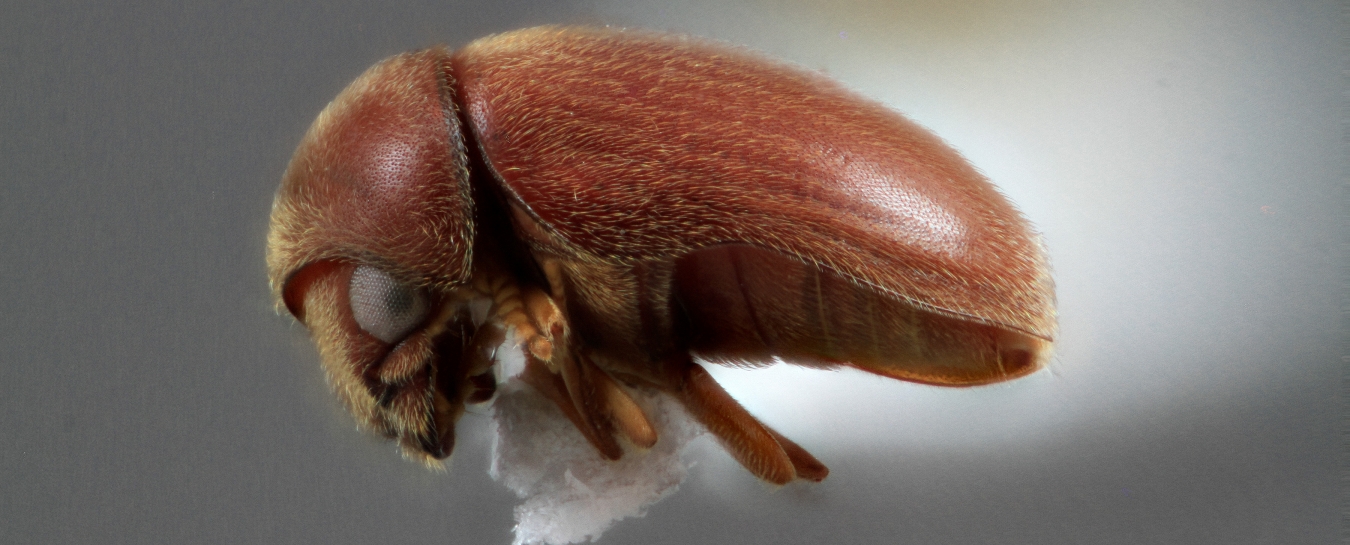
Insects and other Arthropods of the Home
by Schlinger Chair and Curator of Entomology Matthew L. Gimmel, Ph.D.
Given that there are several thousand species of insects and arachnids in the Santa Barbara area, many of which have never been officially reported, it would be virtually impossible to assemble a guide to all insects potentially appearing in human habitations. However, below are a few of the insects and arachnids more commonly encountered in the household.
Insects and spiders can be present in the home for a variety of reasons, most of them benign, such as flying through an open window by accident, or seeking moisture during a dry season, coolness during summer, or warmth during winter. Only occasionally are they a threat to health or property, and most of the time the issue can be solved with simple measures (e.g., cleaning old materials, freezing infested materials, placing vulnerable materials in sealed containers, etc.). One interesting fact to note: over half of the species included below are only present in California because they were brought here, most of them unintentionally, through human activities. This is indicated in the text below where “introduced species” is given as part of an animal’s status.
So what is an arthropod? This is the name given to an enormous group of invertebrate (no backbone) animals that are united by having jointed legs. In these animals, there are visible divisions between each of the segments in a leg (though the number of segments varies). The most familiar arthropods include insects, spiders, mites, harvestmen, scorpions, centipedes, millipedes, and crustaceans. Researchers know that this is a scientifically useful group; that is, the group represents exactly one branch of the animal tree of life. This is to be contrasted with a term like “bugs,” which refers to animals from a variety of disparate branches of the tree of life, such as spiders, mites, insects, roly polies, centipedes and millipedes, as well as some worms, but not many of the branches in between them, like shrimp and lobsters, horseshoe crabs, molluscs, and other small marine animals.
If you have any questions about the information below, or if you’re a resident of the Santa Barbara region and have regularly observed an arthropod in your home that is not in this guide, please suggest it to me at mgimmel@sbnature2.org.
Gray Silverfish, Ctenolepisma longicaudata
Classification: class Insecta; order Zygentoma; family Lepismatidae
Size: maximum about 1 inch (not including appendages)
Status: not dangerous, but sometimes a pest; native species
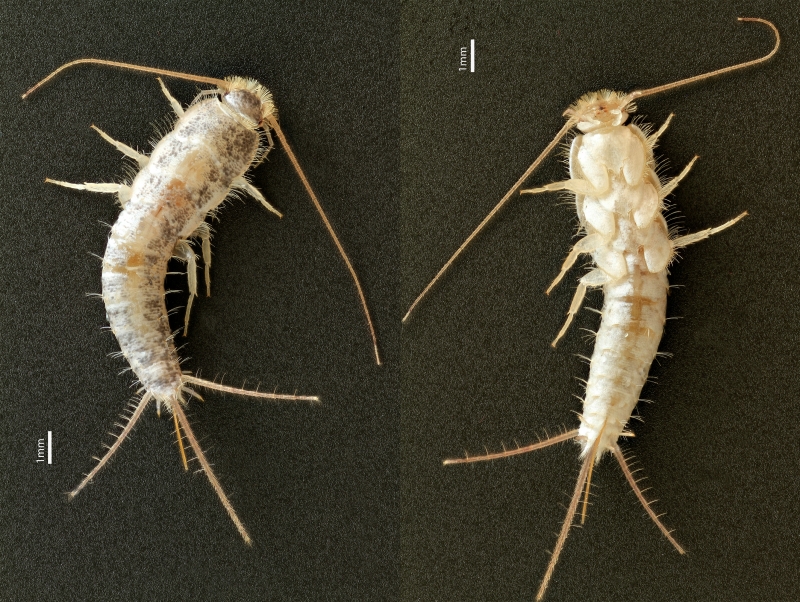
Interestingly, this species of silverfish that we most commonly observe in the home in coastal Southern California is a different genus and species from the common household species over most of the rest of the U.S. (that is Lepisma saccharina). They are fond of chewing on paper with a high chemical pulp (degraded cellulose) content, certain pastes, cellophane, starched clothes, and certain dried foodstuffs, and can occasionally damage or spoil these materials in the home. Sealing these items in tight plastic containers is the best way to keep them silverfish-free.
Gray Silverfish damage to a label; image by Lucie Gimmel
One amazing fact about silverfish is that they are one of the few groups of true insects which are totally wingless; no member of the group, nor any of their ancestors, have or had wings! (The other group that never had wings is the jumping bristletails, or Microcoryphia). These are truly living fossils, having changed their appearance very little in over 350 million years. The three long filaments (which look like tails), are distinctive for this group.
Western Subterranean Termite, Reticulitermes hesperus
Classification: class Insecta; order Blattaria; family Rhinotermitidae
Size: about ½ inch (including wings)
Status: not dangerous, though can cause structural damage to buildings; native species
 Normally not noticed until they swarm, these social insects are ubiquitous in Southern California, and eventually make their way to virtually every wooden structure. Impressive swarms of slow, twinkling, winged reproductive adults generally appear once our weather turns rainy in the late fall (drywood termites typically fly during late summer or early fall). These adults are smaller and darker than drywood termites; their bodies are completely dark brown to black.
Normally not noticed until they swarm, these social insects are ubiquitous in Southern California, and eventually make their way to virtually every wooden structure. Impressive swarms of slow, twinkling, winged reproductive adults generally appear once our weather turns rainy in the late fall (drywood termites typically fly during late summer or early fall). These adults are smaller and darker than drywood termites; their bodies are completely dark brown to black.
The colonies, with their complex caste systems, are composed primarily of pale-colored workers, which are not capable of reproduction, and also of soldiers, which have stout mandibles they use to defend the colony. These colonies generally need a connection to the ground (hence the name) since they are not tolerant of dry conditions. Earthen tubes (tubes made of dirt), which are constructed by the workers, give away their presence.
With the help of special microbes in their guts, termites are able to digest cellulose, one of the main components of wood, but this termite species typically only eats the softer components of the wood (not the harder parts that were laid down during summer), which they carve out along the grain. Unlike many other wood-boring insects, termites do not produce sawdust during their wood-boring activities, they eat it!
Western Drywood Termite, Incisitermes minor
Classification: class Insecta; order Blattaria; family Kalotermitidae
Size: about ¾ inch (including wings)
Status: not dangerous, though can cause structural damage to buildings; native specie
This is a larger species of termite than the subterranean, also not normally noticed until they perform their remarkable mating flights, since the normally wingless members of the colony are concealed within the nest material. Next time you see these fragile insects coming through your window, take a close look at their coloration: unlike the uniformly dark subterraneans, drywood termites have a reddish head!
Also unlike subterranean termites, drywood termites can successfully invade wood that is not in contact with the ground; this means that wood in attics and balconies is fair game. They don’t construct earthen tubes, and often their presence is detected only by piles of frass (insect poop). However, this termite is not responsible for nearly as much structural damage as the previous species. Another behavioral difference from subterraneans: drywood termites eat all components of the wood, and they bore straight across the grain!
Ring-legged Earwig, Euborellia annulipes
Classification: class Insecta; order Dermaptera; family Anisolabididae
Size: maximum about ¾ inch (including forceps)
Status: not dangerous, but can deliver a slight pinch; introduced species
These ubiquitous, omnivorous insects are often present on walls and floors in large numbers on humid nights. They were probably introduced from Europe during the 1800s, and are now widespread across the U.S. While many other earwigs have flight wings, members of this species in our area are wingless. Interestingly, some populations of the species outside the U.S. have winged individuals.
The forceps (pincers) they carry on their hind end may look formidable, but these small insects are only capable of giving a mild pinch, and possess no venom. Earwigs primarily use these forceps in feeding: they swing their abdomens to the side and seize their small insect prey with both their forceps and mouth and tear the hapless prey into shreds! The soft insides of the prey’s body are then consumed.
During their lifespan, these insects undergo gradual metamorphosis, in which the babies that hatch from the eggs resemble tiny adults. This is contrasted with the classic complete metamorphosis of some of the larger insect groups (beetles, moths and butterflies, bees and wasps, flies), which pass through larval and pupal stages that look very little like the adult.
European Earwig, Forficula auricularia
Classification: class Insecta; order Dermaptera; family Forficulidae
Size: maximum about 1 inch (including forceps)
Status: not dangerous, but can deliver a slight pinch; introduced species
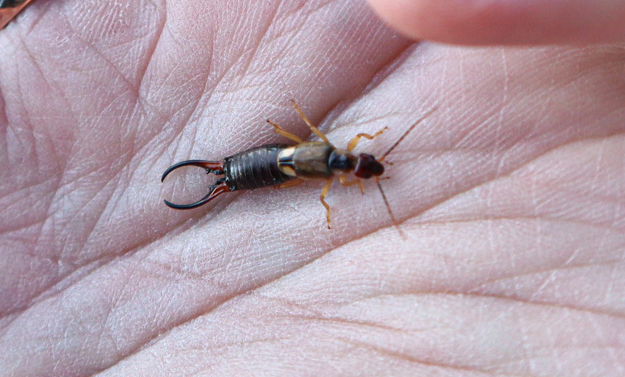
Image by Lucie Gimmel
Perhaps our most common earwig in disturbed areas outdoors, these, unlike the preceding species, have flight wings as adults. Interestingly, their flight wings tuck fan-like underneath their tegmina (leathery front wings). Their bodies are a bit more colorful, too: the head is reddish and the remainder of the body is patterned with yellow and brown. However, like the previous species, this one was introduced into California from Europe; this one arrived a bit later, during the 1920s, and has since become arguably our most common and widespread species of earwig.
Their forceps are longer than in the preceding species, and show sexual dimorphism: males and females have differently shaped forceps. In males, the forceps are longer and more gradually curved, with strong opposing tooth-like structures at the base; in females, the forceps are straighter with a small, abrupt curvature at the tips, and no large tooth-like structures are present. The photo above shows a male.
Cigarette Beetle, Lasioderma serricorne
Classification: class Insecta; order Coleoptera; family Ptinidae
Size: about 1/8 inch
Status: not dangerous, but sometimes a serious pest; introduced species
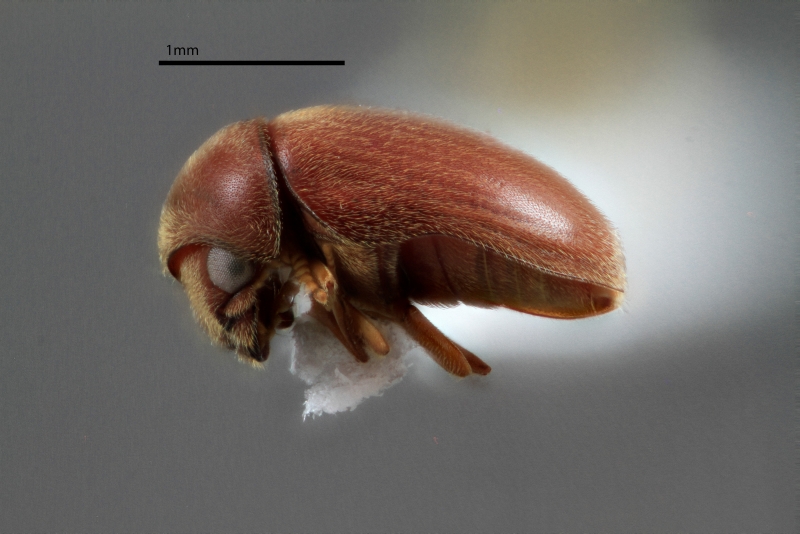
Image by Lucie Gimmel
These beetles can be terribly destructive pests of stored products, often operating quietly for months or years before an outbreak is discovered. They have an insatiable appetite for dried foodstuffs of many varieties, though they received their common name for their habit of feeding on stored tobacco. The adults are tiny, reddish-brown beetles that are able to tuck their head against their thorax (the middle part of the body) and pull their legs and antennae snugly against the body, partially rolling into a ball. Like other insects, they have special kidney-like structures called Malpighian tubules, but these are unique in being attached to the rectum, allowing water transfer from the gut back into the body cavity. This saves water and allows these beetles to survive under extremely dry conditions.
Varied Carpet Beetle, Anthrenus verbasci
Classification: class Insecta; order Coleoptera; family Dermestidae
Size: about 1/8 inch
Status: not dangerous, but sometimes a serious pest; introduced species
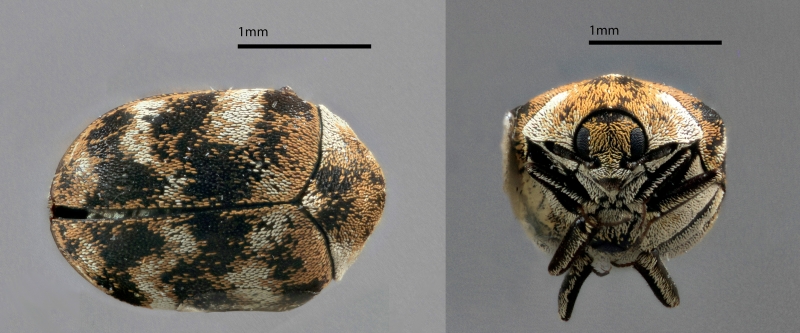
Images by Lucie Gimmel
The bane of museum entomologists, these beetles have a taste for animal protein and can reduce an insect collection to dust over a few years. The spiky-haired larvae do most of the feeding; these can damage woolen carpets, clothing, dried meats, animal skins, and dried cheese, but have also been reported feeding on grain-based products, nuts, and spices. Often their presence in a building is not discovered until the colorful little adult beetles are seen in numbers on windows and windowsills, attracted by the light when trying to disperse.
While North America has a large number of native species of the dermestid beetle family, many of which can be pests, this species was introduced from Europe and now can scarcely be found away from human habitation.
Crane fly, Tipula (Lunatipula) and Tipula (Triplicitipula) species
Classification: class Insecta; order Diptera; family Tipulidae
Size: maximum about 1 inch (not including appendages)
Status: not dangerous; native species
Image by Lucie Gimmel
People often refer to these large, leggy flies as “mosquito eaters,” or believe they are giant mosquitoes. Both, however, are untrue. The adult crane fly, in fact, does not feed on much of anything. Their mouths are reduced and can only lap up droplets of water and nectar. Their larvae are large maggots that live in wet, mucky places. Like the larvae of many insects, nearly all of the fly’s nutrition and energy stores are amassed during this feeding stage, powering the adult insect during the relatively short-lived final life stage. Adult males have a swollen end of the abdomen (as in the above photo), which houses their often-complex genitalia with sundry three-dimensional branches and spines, uniquely formed in each species; however, in females the abdomen is merely tapered to a point and houses a telescoping ovipositor (egg-laying device).
While there are about 500 species of crane flies in California—many of them very difficult to separate without detailed examination—Tipula (Triplicitipula) planicornis is arguably the most common one in our area. The photo above is of a male Tipula (Lunatipula) inusitata, which can also be common. These slow, clumsy fliers often appear in great numbers across the landscape during the spring months, flying to porch lights and accidentally letting themselves into the home when the door opens!
Dark-winged Fungus Gnat, Bradysia tilicola
Classification: class Insecta; order Diptera; family Sciaridae
Size: about 1/10 inch
Status: not dangerous; introduced species
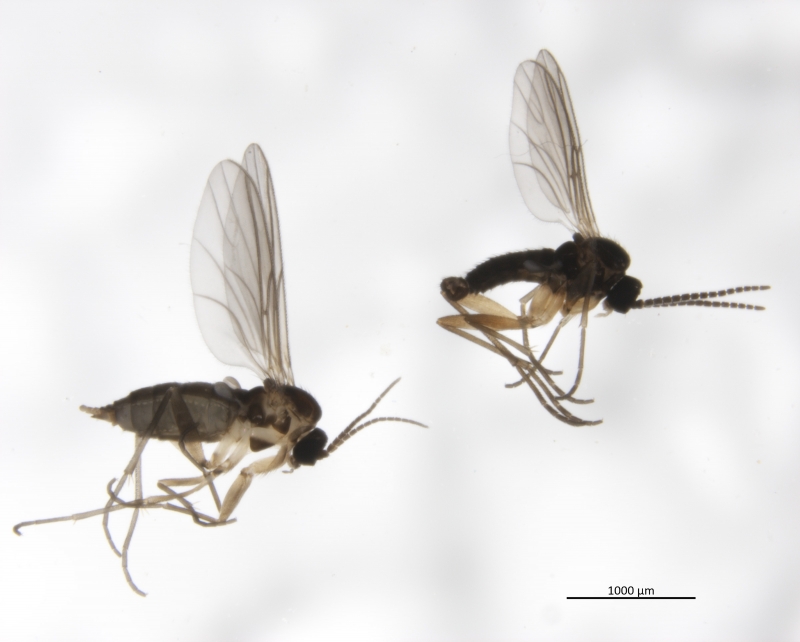
Image by Matthew Gimmel
You may not recognize this insect at close range, but you have almost certainly inhaled it. These tiny flies are perhaps the most common insect flying up people’s noses indoors! Adults have the annoying habit of flying slowly but erratically in high-humidity spots. They are ultra-common in houses worldwide as a result of their larvae developing within the soil of potted plants; they almost never do damage to living plants, but are reported to be occasional pests of commercial mushroom farms.
Should you be able to have a look at one of these delicate little flies through a microscope, you might see a peculiar structural feature: the eyes are connected via a bridge of eye facets on the top of the head. Like crane flies, the male (on right in above image) has a bulbous end of the abdomen containing the genitalia, whereas the female (left in above image) has a tapered abdomen.
Drain Fly, Clogmia albipunctata
Classification: class Insecta; order Diptera; family Psychodidae
Size: about 1/8 inch
Status: not dangerous, but sometimes a sign of dirty or leaky plumbing; introduced species
How these are usually observed; image by Lucie Gimmel
These cute little flies are covered with grayish hairs and hold their wings over their bodies in a distinctive flat, shelf-like fashion. The larvae develop in wet, mucky habitats with organic matter (sometimes a dirty drain pipe or around a pipe leak, hence the common name!), and the adults are weak fliers and generally don’t fly far from the larval habitat. Consequently, these flies are often found in kitchens and bathrooms, and near cesspools and wastewater treatment plants.
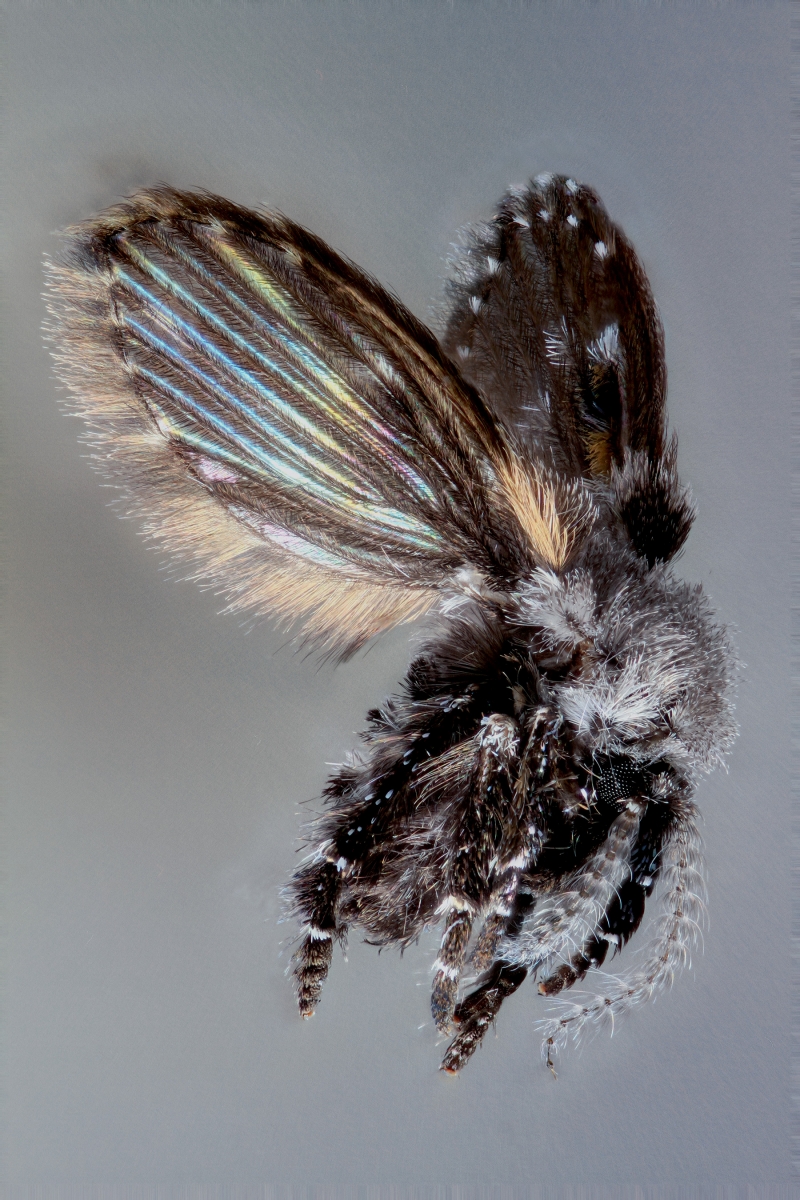
SBMNH specimen; image by Lucie Gimmel
Geranium Plume Moth, Amblyptilia pica
Classification: class Insecta; order Lepidoptera; family Pterophoridae
Size: wingspan about ¾ inch
Status: not dangerous, but sometimes does minor damage to Pelargonium plants; native species
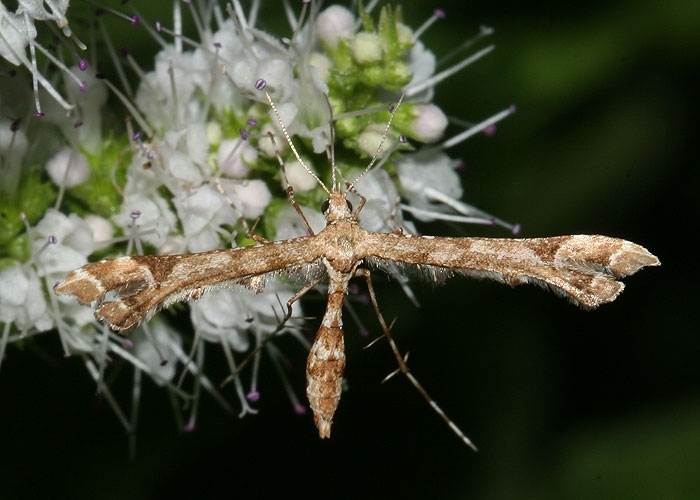
Image by Larry Friesen
This species of moth occurs in about the western half of North America, and can be a greenhouse pest on geraniums. The larvae (caterpillars) actually feed on lots of different plant species in various families, including Castilleja, snapdragons, and some mints, and of course on ornamental geraniums (Pelargonium). They feed externally on foliage and flower buds, but also bore into seedpods and mine (feed within) the leaves; they are well camouflaged and difficult to observe. During 2018, I observed an adult female ovipositing (laying eggs) into a Pelargonium plant on our balcony. Since these plants are frequently kept on windowsills and balconies, the moths often wander inside through windows and doors.
The family that this species belongs to, the plume moths, is unique among moths in the way they hold their wings at rest, giving the moth a T-shaped appearance. There are several species of this family in California. Adults of this particular species can be recognized by the mottled triangle pattern on the wings.
Household Casebearer Moth, Phereoeca uterella
Classification: class Insecta; order Lepidoptera; family Tineidae
Size: case about ½ inch
Status: not dangerous, but can be a pest of wool; probably native species
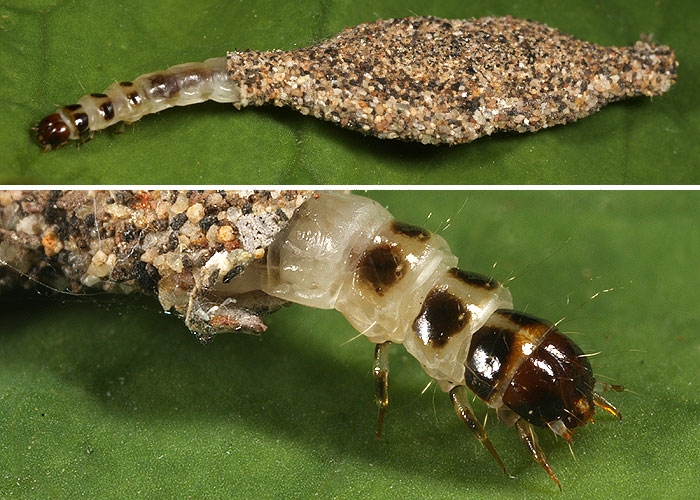
Image by Larry Friesen
Have you ever noticed fuzzy, gray, pumpkin-seed-shaped objects about a half-inch long moving up your wall? These are the cases of a casebearer moth caterpillar. These remarkable little larvae construct their cases out of spun silk combined with bits of sand and dirt. That shape, by the way, has a purpose: there is a hole at each of the narrow ends big enough for the slender larva to fit through. Amazingly, the larva can tuck completely inside, do a U-turn, and pop its head out the opposite side!
What are they doing in your house? Like the carpet beetles above, they’ve got a taste for animal protein. Often they’re innocuously feeding on spiderwebs that collect along your baseboards, but sometimes they feed on woolen products, including rugs, sweaters, and blankets. When the larva is ready, it seals off the ends of the case and pupates. What emerges is a tiny, brown-banded, rarely noticed adult moth.
Argentine Ant, Linepithema humile
Classification: class Insecta; order Hymenoptera; family Formicidae
Size: workers about 1/10 inch
Status: not dangerous, doesn’t sting, but can give a nonvenomous bite if provoked; introduced species
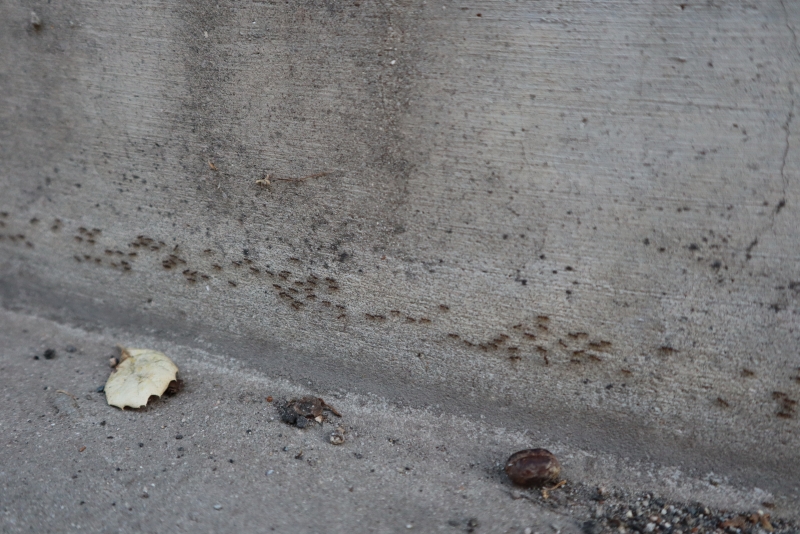
Image by Lucie Gimmel
This small ant is one of the most destructive introduced pests in California. Population densities of this originally South American species can be huge, and they are omnivores that can eat almost anything. Besides being extremely difficult to eradicate from houses once they are established, they can dramatically alter habitats where they are present, and are well-known exterminators of other ant species in an area. They nest in a wide variety of places, including in soil and under debris, in holes and hollows built by other animals, in nests, dead trees, etc. Colonies can be huge; this is in large part a result of their having multiple queens laying eggs within a single nest.
Fortunately for much of North America, these ants are limited in their distribution by freezing temperatures and lack of water, so more northern latitudes, higher elevations, and desert areas are relatively free of them, though temperate microclimates with moisture can often be found around human habitation almost anywhere.
Long-legged Sac Spider, Cheiracanthium mildei
Classification: class Arachnida; order Araneae; family Cheiracanthiidae
Size: maximum about 2/5 inch (not including legs)
Status: not dangerous, though has been falsely accused of causing blisters and lesions; native species
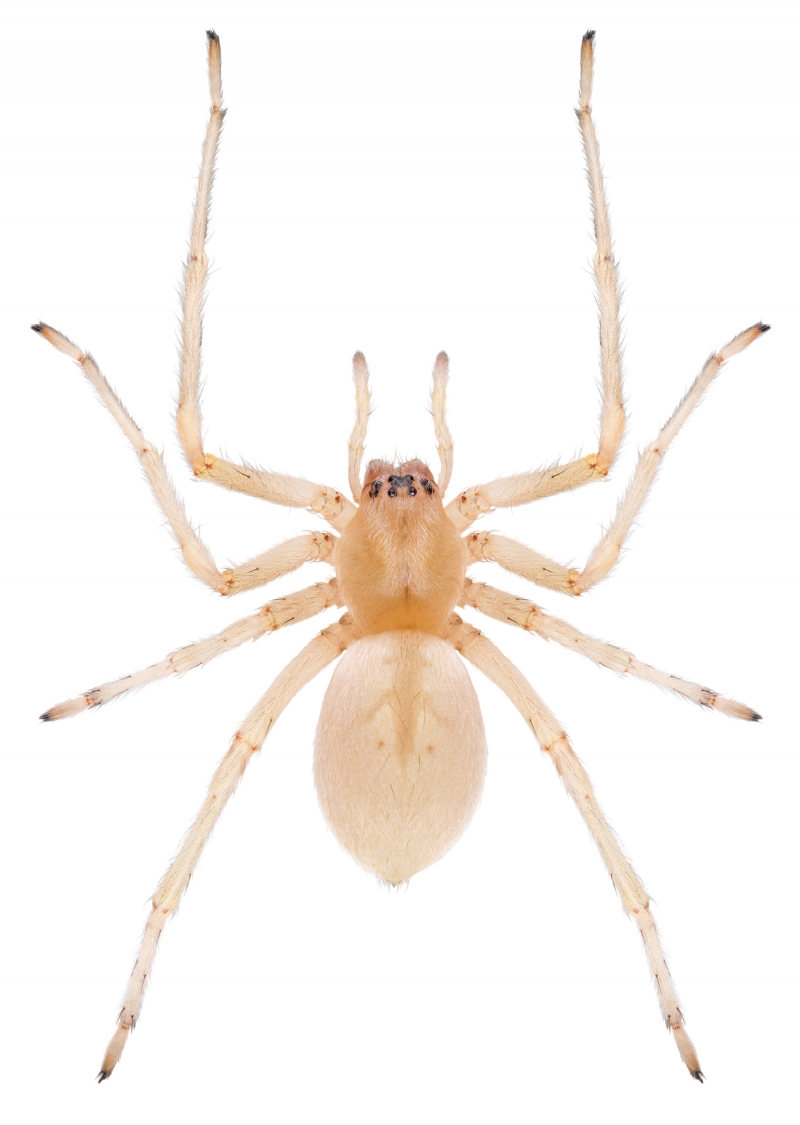
This common indoor spider does not construct a web for capturing prey. Instead, it constructs a silk sac to rest in by day, and hunts for small insect prey during the night. While they are known to bite people, the effects are observably no worse that a bee sting, just as in most other spiders large enough to bite, despite a few unsubstantiated and purely circumstantial claims to the contrary. This spider should not be considered medically important.
These spiders can usually be recognized by their chunky, pale, straw-yellow bodies with pale legs that have a slight darkening at the tips of the tarsi (feet), and the front pair of legs being the longest pair.
Cellar Spider or Daddy-long-legs Spider, Pholcus phalangioides
Classification: class Arachnida; order Araneae; family Pholcidae
Size: maximum about ½ inch (not including legs)
Status: not dangerous, and often a beneficial household resident; introduced species
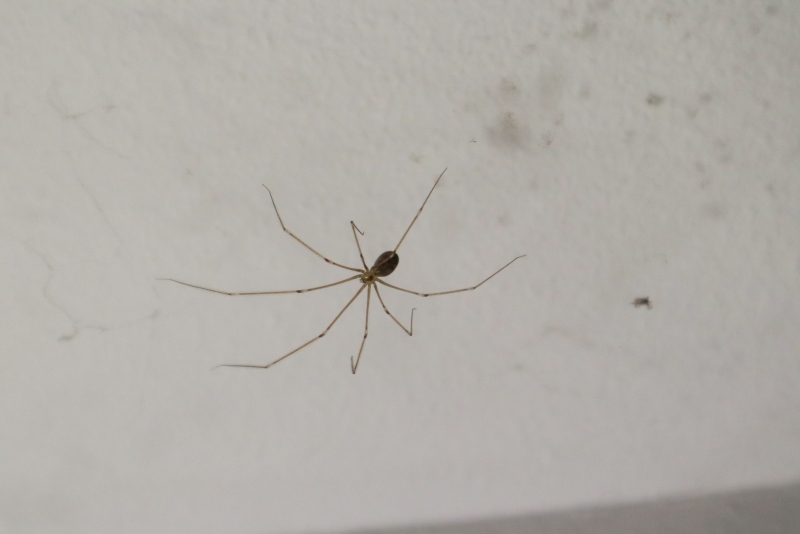
Image by Lucie Gimmel
These are interesting spiders that are well-known for making a loose web in the corner of a room, and are probably responsible for most cobwebs in houses. When disturbed, these leggy beasts often make a strange gyrating motion in their web, which may be confusing to potential predators or may help the spider tangle an approaching insect in its web. Many species of the family Pholcidae occur in caves and hollow trees in the wild, but there are a few that actually prefer living in man-made structures. The females carry their eggs in their chelicerae (jaws) before hatching.
If you can tolerate their presence, these sedentary spiders can actually be beneficial to have around as they can reduce the number of not only flying and crawling pestiferous insects, but can even prey on other, sometimes dangerous, spiders in some instances. They are known to wander a short distance from their own webs and bait another spider into attacking them, at which point they kill and eat the unsuspecting spider!
This is a good opportunity to help dispel a pernicious myth: many people repeat the bogus claim that these are the most venomous spiders in the world, but their fangs are too small to bite humans. This is completely untrue. The venom of these spiders is no more toxic than that of an average spider (virtually all spiders have venom glands!). These spiders, also like most others, do have fangs and in large individuals these are technically capable of piercing human skin. However, these spiders are not at all aggressive and bites are exceedingly rare and produce nothing more than a short-lived stinging sensation.
One additional note: do not confuse these spiders with another group of animals often called “daddy-long-legs” or “granddaddy-long-legs,” the harvestmen (order Opiliones). These have an oval body that looks like a single segment (not two segments as in spiders), and they have no fangs or venom glands. Unfortunately, the above myth often gets applied to them as well!
Roly Poly or Common Pill Bug, Armadillidium vulgare
Classification: class Malacostraca; order Isopoda; family Armadillidiidae
Size: maximum about ½ inch
Status: not dangerous; introduced species
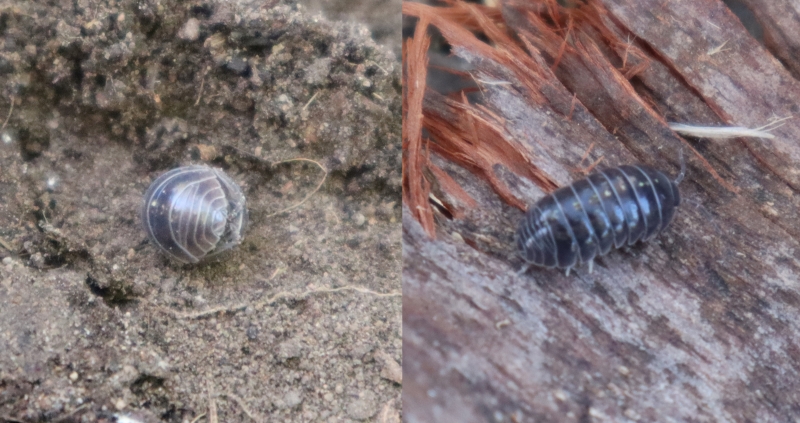
Images by Lucie Gimmel
For those living at ground level or below, these immigrants of European origin are common in the household. Pill bugs are crustaceans: this is the group that includes shrimp, crabs, and lobsters. Crustaceans are extremely diverse in aquatic environments, especially the sea, but are very limited on land, with only a few species completing their life cycles without submerging in water. Pill bugs, however, will die in liquid water. However, even these landlubbers still retain the aquatic-style breathing method of their ancestors: they have gills. Consequently, pill bugs still need to inhabit moist environments, in which they’re able to keep their gills hydrated, in order to survive.
Top image by Lucie Gimmel


